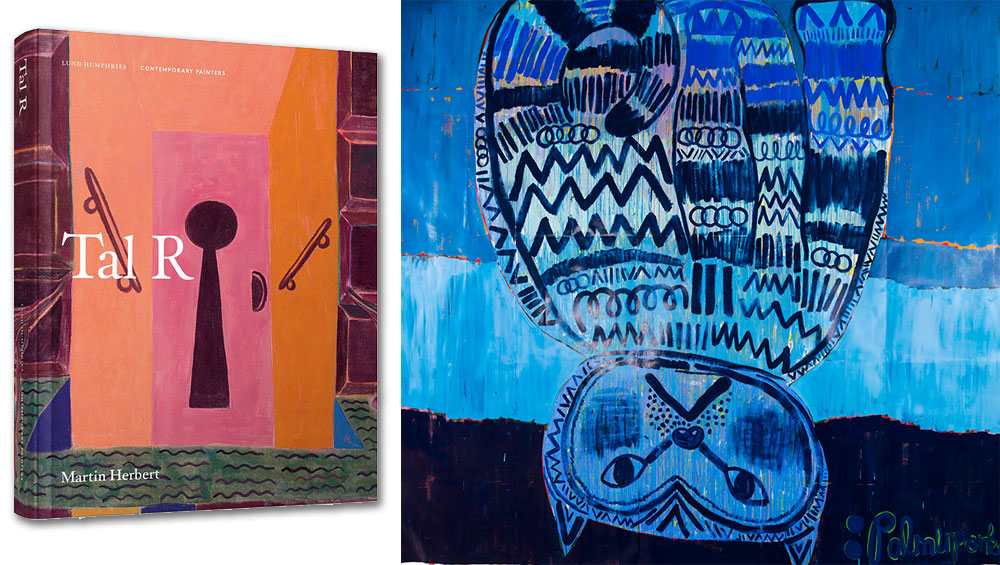
Tal R by Martin Herbert, cover; Palmer Park, 2018. Acrylic on cardboard, 453 × 480 cm (178 × 189 in). Private collection.
reviewed by JANET McKENZIE
Tal R is the subject of a book by Martin Herbert in Lund Humphries’ excellent Contemporary Painters series, edited by Barry Schwabsky. Although Tal R has had a remarkable international career and received critical recognition, the new title is the first comprehensive appraisal of his work. Born Tal Shlomo Rosenzweig in Tel Aviv, in 1967, to a Czechoslovakian father (a Holocaust survivor) and a Danish mother, he grew up in Denmark, and lives and works in Copenhagen. An articulate artist and teacher, Tal R was interviewed by Ben Luke for the podcast series, A brush with … (January 2021) where he spoke eloquently about creative process, citing influences such as Georges Rouault, Marsden Hartley and Alfred Wallis. He often refers to a persistent feeling of being an outsider.
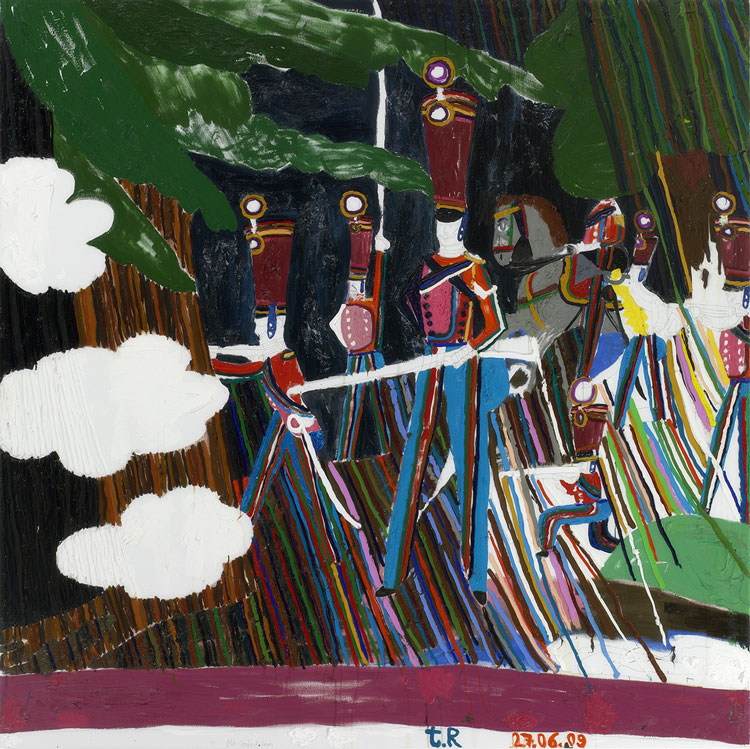
Tal R, Old Confused Gun, 2009. Oil on canvas, 200 × 200 cm (78 × 78 in). Magasin III, Stockholm.
Looking at his powerful and distinctive oeuvre makes the notion of the death of painting thankfully absurd. His work also triggers elusive issues about the role of art in our complex world in extremis. While many of his works possess an apparent innocence of childhood, the unique blend of amusing, enigmatic and surreal creates a potent sense of unease. Herbert’s text offers an authoritative account of his inspiring career thus far. In doing so, he helps to explain and encourage a way forward for artists after modernism and post-modernism without apology.
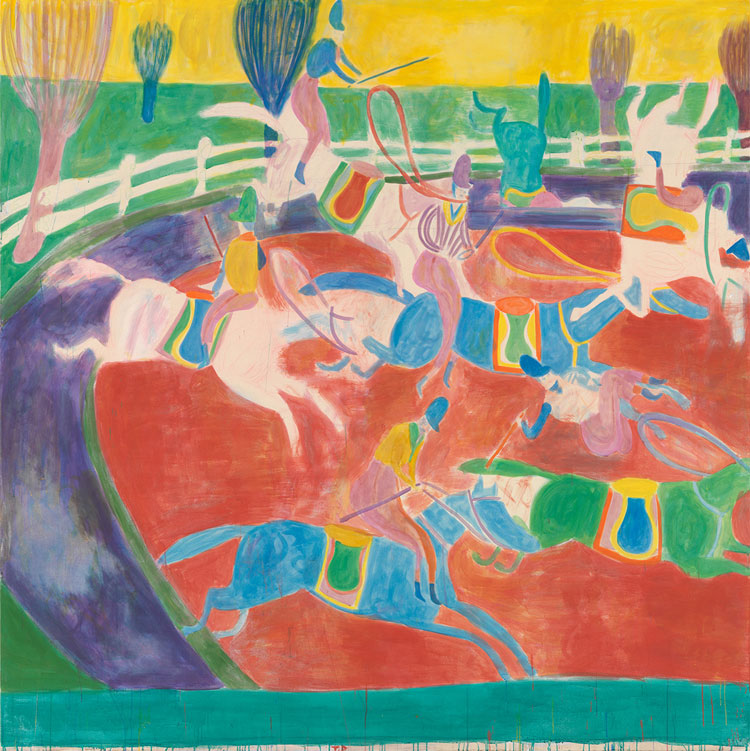
Tal R, Haute Couture, 2010. Crayon, pigment and rabbit-skin glue on canvas, 250 × 250 × 4.5 cm (98 × 98 × 1 in). Collection of Bo and Britt Bjerggaard.
For many years, Tal R taught at the Kunstakademie Düsseldorf. Schwabsky, in his foreword, described the artist’s attempt to inculcate the students there with his views. Tal R told Herbert that his approach is based on his instinctual method, learning to allow mistakes to be made in order to move forward: “You should invest in failing. Invest in losing. Get comfortable with that. Don’t ask why something meant something to you, but try to articulate it. Slowly, you will find your way. There will be things that you hate in your painting which will suddenly become your option and your possibility.” Both art history and quirky personal objects from his past become key elements in the exuberant, vivid compositions. He encourages his students to embrace and accept their ugly, boring personal history.
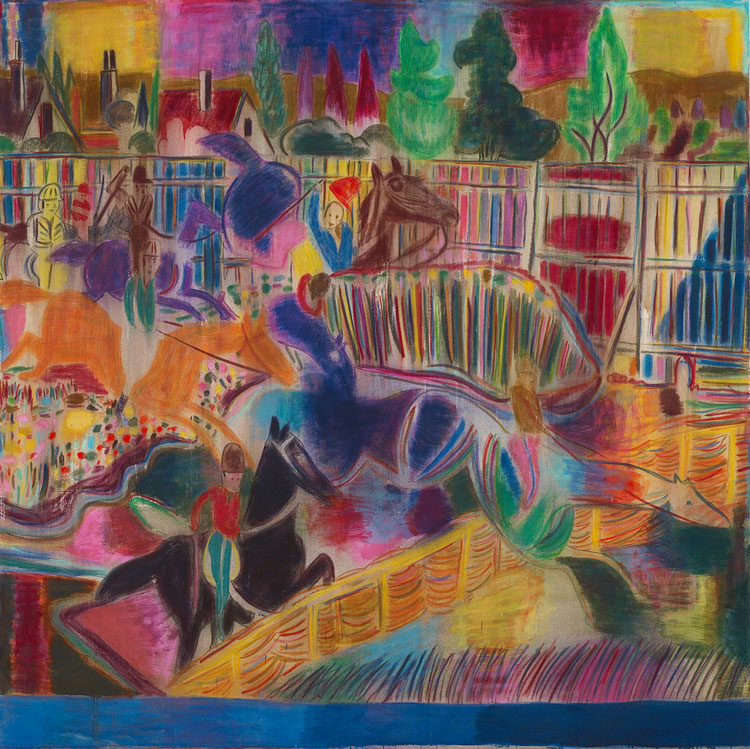
Tal R, Hermes, 2011. Crayon, pigment and rabbit-skin glue on canvas, 250 × 250 × 10 cm (98 × 98 x 4 in). Private collection.
Tal R’s enigmatic work offers intersections of personal experience and wider history through a visual jigsaw, finely balanced between abstract shapes and fields of colour. The works are at once familiar and estranged. In technical terms, the employment of a vivid but limited palette is underpinned by a fluid stream of consciousness-style drawing. The format of many works can be seen to refer to the layout of the screen of early 80s video games. His painting and drawing merge the essential fast-moving character and narrative of comic books, graffiti, children’s art and outsider art. It is exciting to behold, energetic, chaotic often menacing, the random compositions forming deep signifiers in subconscious conceptual terms. Yet Herbert is keen to assert that we should not be taken in by the apparent reference to children’s literature: “For while Tal R’s work has repeatedly been read through a critical framework that speaks of deliberate naivety – less and less tenably so as his art has developed – his relationship to childhood is complicated and has very little to do with innocence. He does not want to draw or sculpt like a child, but he does desire to approach and refract seeing with the alpha-wave intensity of childhood. His timeline is thus a primer in sustaining the quicksilver quality of enchantment, on both sides of the creative process: for the artist the making, for the viewer the reception.” In this, he shares the drive of the French-born Australian artist Mirka Mora (1928-2018), whose Jewishness was given originality and hope through a long artistic career, celebrated for most of this year at the Jewish Museum of Australia in Melbourne.
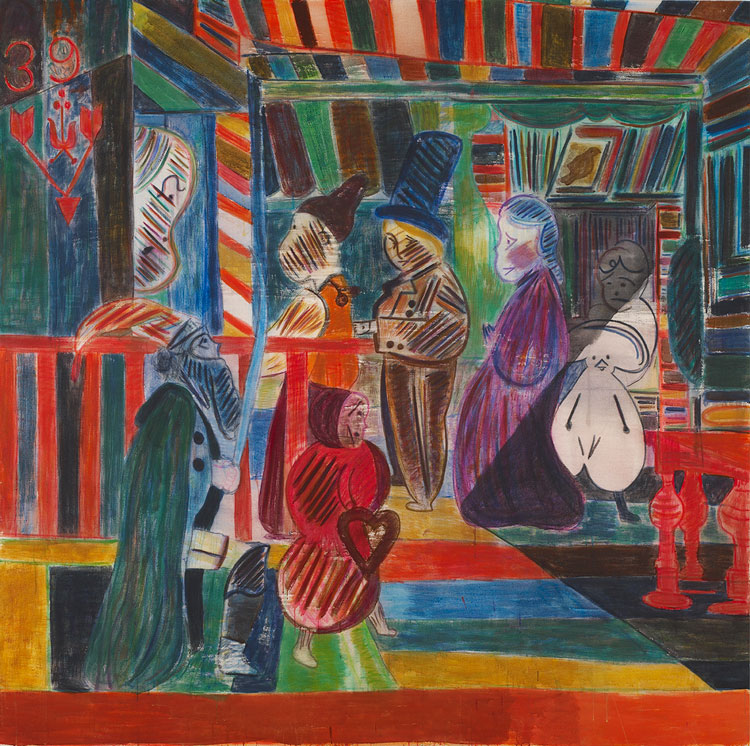
Tal R, March to Goodwill, 2011. Crayon, pigment and rabbit-skin glue on canvas, 250 × 250 × 10 cm (98 × 98 × 10 in). Private collection.
In combining conceptual process with subjective, quotidian observation and knowledge of fauvism, symbolism and folk art, Tal R’s works are replete with subconscious association that act as triggers for the viewer to experience. I identified in his early drawings, a smörgåsbord before reading that he has used the term kolbojnik, a Hebrew term for leftovers. With either, viewers are able to serve themselves, to identify elements with personal resonance, while the artist alludes to cultural heritage, quotidian rituals that often centre on mealtimes and in doing so, asserts the importance and survival of family, the result of his own dual heritage and global culture. The food metaphor continues with Tal R describing his studio practice in culinary terms: “I do painting a bit like people make a lunch box. I constantly have this hot-pot boiling and I throw all kinds of material into it.”
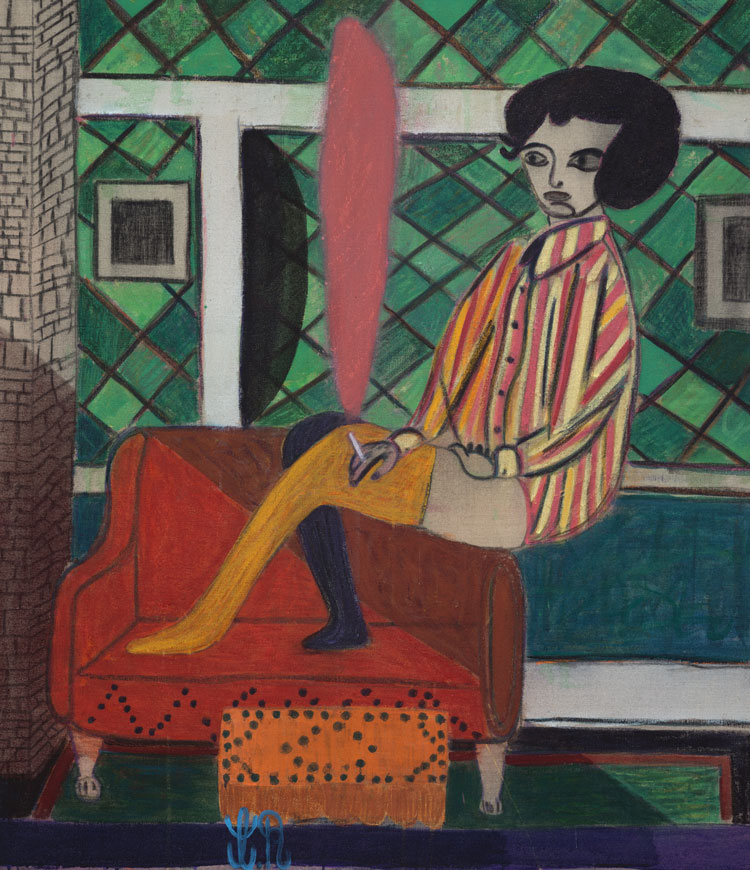
Tal R, Rosa Smoke, 2013. Crayon, pigment and rabbit-skin glue on canvas, 112 × 97 cm (44 × 38 in). Private collection.
His enigmatic work transforms everything in his life; as a keen observer, he draws from external reality where his work is characterised by quick perceptual sketches as well as from his imagination. The two sources become a singular vision through fluid drawn images. His work acknowledges Scandinavian culture, art nouveau design principles, outsider art and children’s art.
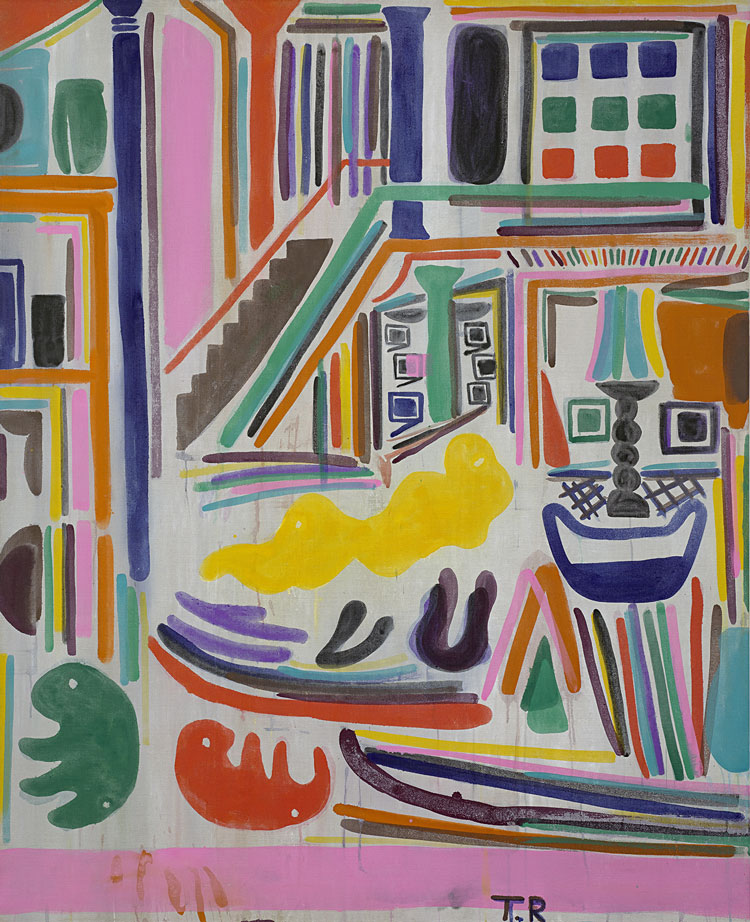
Tal R, The Drawing Class, 2014. Crayon, pigment and rabbit-skin glue on canvas, 172 × 140 cm (67 × 55 in). Collection of Howard and Katie Read.
Just as the artist chose Academy of Tal R as the title of his 2017 artist book, in order to assert the irony of his studio practice, which is anything but academic, he explodes a scene and reconstructs it as a potent image, a narrative that recalls the British artist Cornelia Parker’s 1991 work Cold Dark Matter: An Exploded View. She uses the explosion as an archetypal image, familiar to us through life. In an interview in 2011, she told the Tate curator Michela Parkin: “Somehow the idea and imminence of the ‘explosion’ in society seemed such an iconic thing. You were being constantly bombarded with its imagery, from the violence of the comic strip, through action films, in documentaries about Super Novas and the Big Bang, and least of all on the news in never ending reports of war.” Tal R’s own ability to explode or deconstruct an amalgam of forms was enabled by the early use of collage.
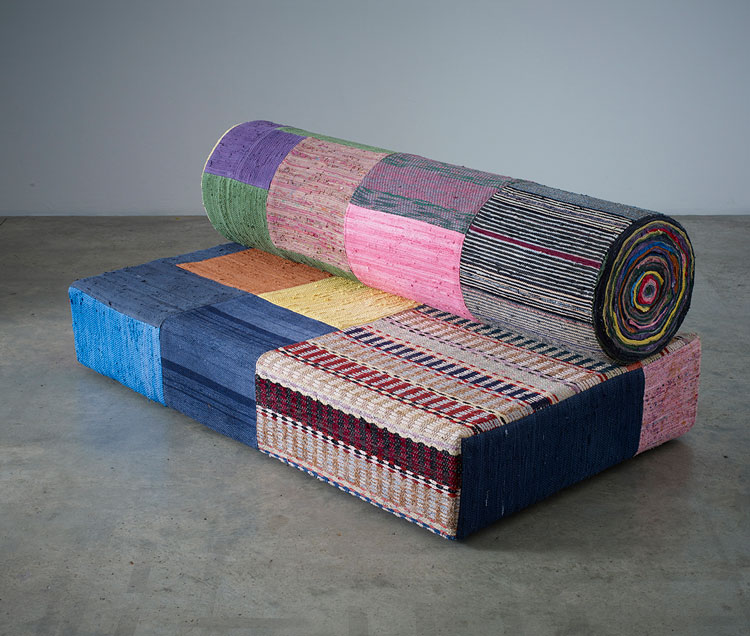
Tal R, Retired Professor, 2014. Rag rugs and foam on wood, Sofa: 83 × 200 × 118 cm; Top part: 48 × 200 × 48 cm. Victoria Miro, London/Venice.
Academy of Tal R, edited by Anders Kold and Lærke Rydal Jørgensen, reveals his prolific, obsessive approach to art and his compulsion to respond to the chaos of life from quotidian objects, rituals and familiar forms from art history. He creates a sense of involvement in a domestic world because it represents family and survival. Described as an artist’s artist (due to the fluidity with which he collects images, imitates the giants (Picasso and the Fauves), his idiosyncratic drawings simultaneously evoke the universal and the subjective. We are drawn in to the brooding adolescent doodles, feel exhilarated by the inclusivity of his attitudes and enjoy his irreverent mix. Sexuality is explored through a preponderance of, mostly female, nudes in highly charged settings. The 2017 exhibition Keyhole, at Cheim & Read, New York, presented 11 large-scale paintings and 10 works on paper (one of which is used as the cover image of Herbert’s monograph) depicting the exteriors of sex shops, brothels and gay bars.
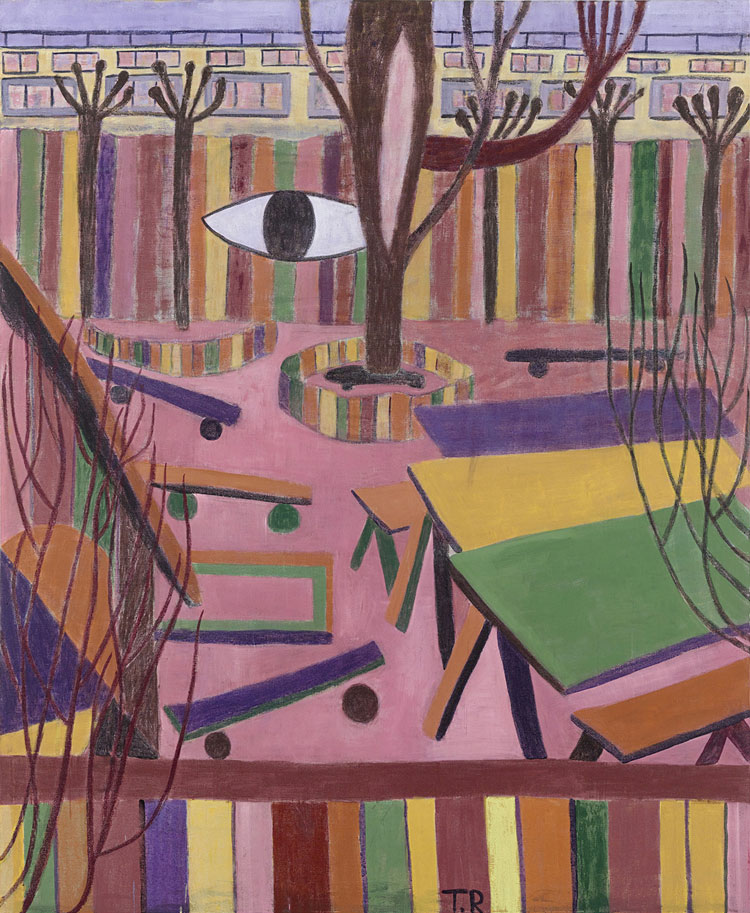
Tal R, Deaf Institute, 2016. Pigment and rabbit-skin glue on canvas, 244 × 200 cm (96 × 78 in). KII Art Foundation, Hong Kong.
I fell for the intriguing work of Tal R through his drawings in black pigment and rabbit-skin glue. I had been writing about contemporary drawing since 1986, but the visionary authenticity of his graphic images blew me away. They felt encouraging of the essential creative act, the freedom to draw with the humble ballpoint pen enabling a visual stream of consciousness as first language. Drawing, as the most direct form of expression, is an appropriate means of traversing the critical storms and cul-de-sacs that have created barriers for the comprehension and enjoyment of much contemporary art. The poet Seamus Heaney (1939-2013) described drawing as an art form that occupies “a placeless heaven”, freed from the literal. “Drawing is closer to the pure moment of perception. The blanknesses, which the line travels through in a drawing, are not evidence of any incapacity on the artist’s part to fill them in. They attest rather to an absolute and all-absorbing need within the line itself to keep on the move. And it is exactly that self-propulsion and airy career of drawing, that mood of buoyancy, that sense of self-sufficiency in the discovery of a direction rather than any sense of anxiety about the need for a destination, it is this kind of certitude and nonchalance which distinguishes the best of [the poet] Kavanagh’s later work also.”1 Heaney’s own career as a writer was constantly informed by the questions that artists also address in their work: how should artists or writers live and create? What is the relationship between art practice and art objects; between the creative act and the artist or writer whose voice informs it; one’s literary heritage and the contemporary world?
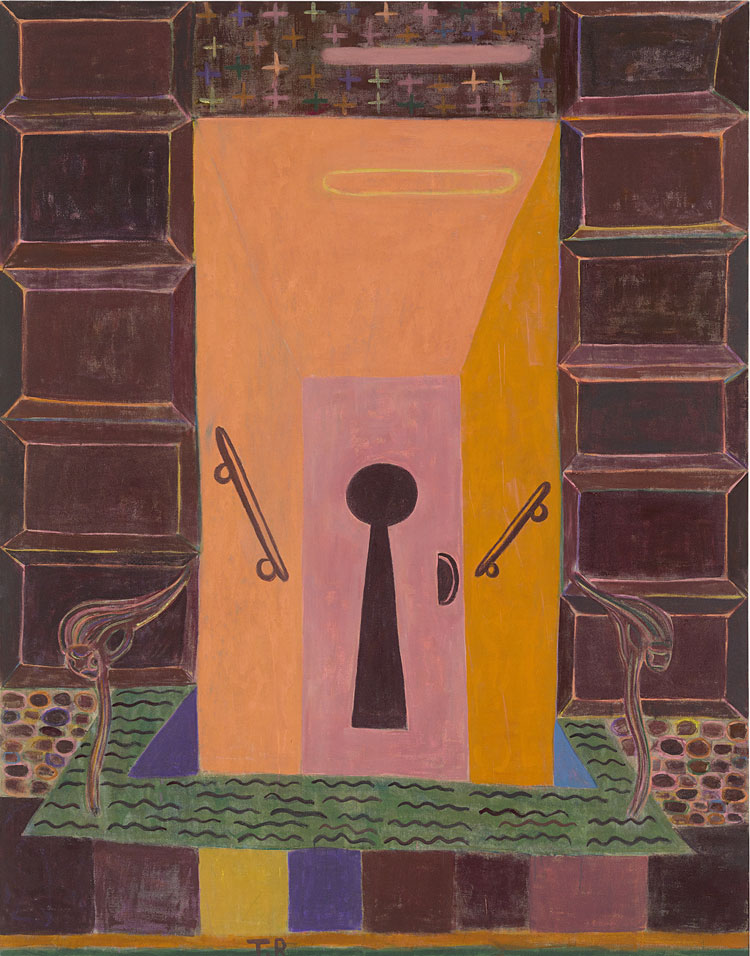
Tal R, Keyhole, 2016. Pigment and rabbit-skin glue on canvas, 240 x 188 cm (94 × 74 in). Courtesy of the artist and Cheim & Reid, New York.
In many of the early drawings of Tal R, there are singular identifiable stories being told. He straddles abstract patterning that might have been observed on a Persian rug or a Matisse still life. There are symbolic forms (the caged bird) and a sense that the artist belongs to the rich northern tradition, from Hieronymus Bosch (1450-1516) and Pieter Bruegel (c1525-69) to Max Beckmann (1884-1950). Latterly, his work can be compared with that of more recent northern artists including Edvard Munch, Asger Jorn, Per Kirkeby and Georg Baselitz.

Tal R, House Red, 2018. Oil on canvas, 200 x 147 cm (78 × 58 in). Courtesy of the artist and Victoria Miro, London/Venice.
In the working method of Tal R’s drawings, there are notable exceptions to the stream of consciousness pen works and mixed media works. For example, in his book Sexshops, he presents 99 drawings (from 2014-17) that use different approaches. Some are made from photographs of the shopfronts of sex shops from all over the world that have been gifted from his students at Kunstakademie Düsseldorf, some are drawn from personal memory and others from the descriptions of his friends. The unique collaboration results in a cohesive body of work in crayon, pigment and rabbit-skin glue offering voyeurism for the viewer. By contrast, linear ink drawings or the more explosive mixed media works, such as Lords of Kolbojnik (2002-3) and Adieu Interessant (Silver) (2005-8) test the picture plane through violent evocation, perhaps alluding to his family’s horrific persecution. Drawn to aspects of culture and everyday life, Sisters of Kolbojnik (2002) depicts a gang of long-haired, bell-bottomed nymphs in a magic-mushroom forest. It has been described as “a celebration of overlooked wall-flower beauty, as socially inclusive as a community mural”.
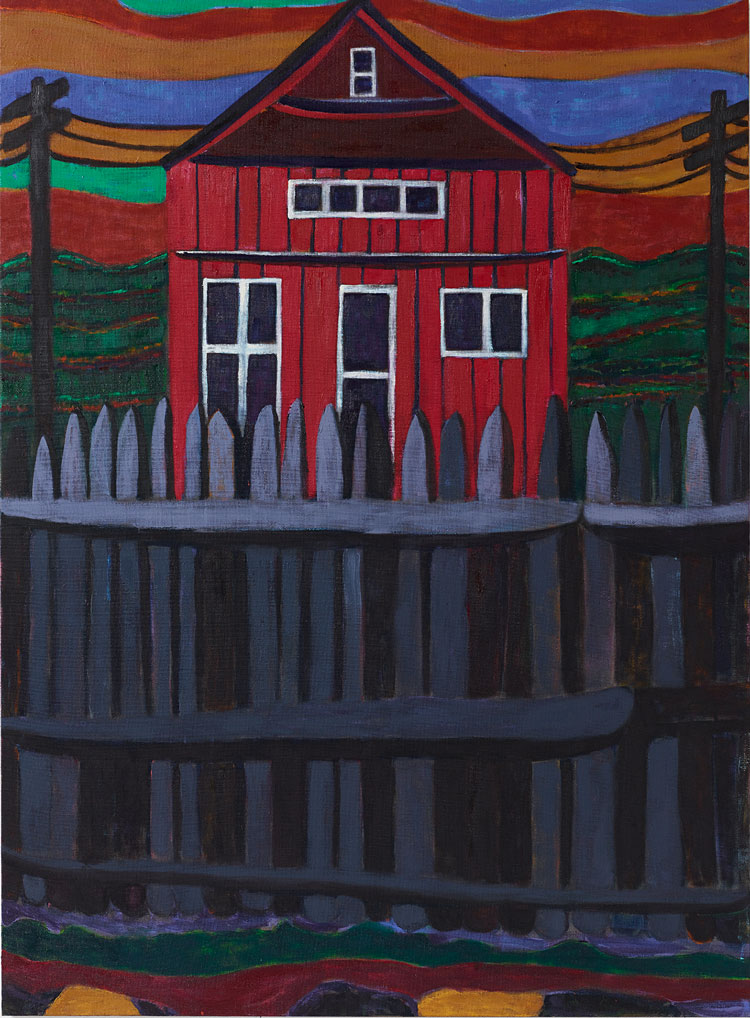
Tal R, Riders in the Sky, 2002. Oil and crayon on canvas, 250 × 250 cm (98 × 98 in). Private collection.
Herbert’s text makes many poignant observations on the artist’s life and prolific career: “[Tal R] refers to overly skilled artistic productions as ‘Persian carpets’ and when he catches himself becoming facile, pivots into a modality he has not mastered. He prefers to inhabit a slipstream of not knowing and trust in the subconscious, the percolating back-brain, and not only in formal terms; he also has a deep animus towards symbolism, imagery standing for something. Conversely, for Tal R, a painting (in particular) is not an encoding of something but a thing in itself, at best, a Promethean, breathing entity. ‘I don’t want to make a painting where you travel to Narnia and when you get there, there’s just a cup of tea,’ [he told Herbert:] switching literary foci, ‘I want to paint a cup of tea that leads you to Narnia.’”
Tal R, the book, is essential reading for all lovers of painting and contemporary art and culture. It captures the generosity involved in visualising the complex subconscious experiences that define our humanity at an overbearing period in history. And it teaches individual artists a profound lesson about who we are and the “inner necessity”,2 of creative practice and art as a form of nourishment (of consciousness, the spirit).3
References
1. Seamus Heaney, excerpt from his essay The Placeless Heaven, on the poet Patrick Kavanagh in Finders Keepers: Selected Prose, 1971-2001, Faber and Faber, London, 2002.
2. Concerning the Spiritual in Art, Wassily Kandinsky, 1910.
3. As Consciousness Is Harnessed to Flesh: Journals and Notebooks, 1964-1980, second volume of the published diaries, by Susan Sontag.
• Tal R by Martin Herbert is published by Lund Humphries, London, price £39.95.